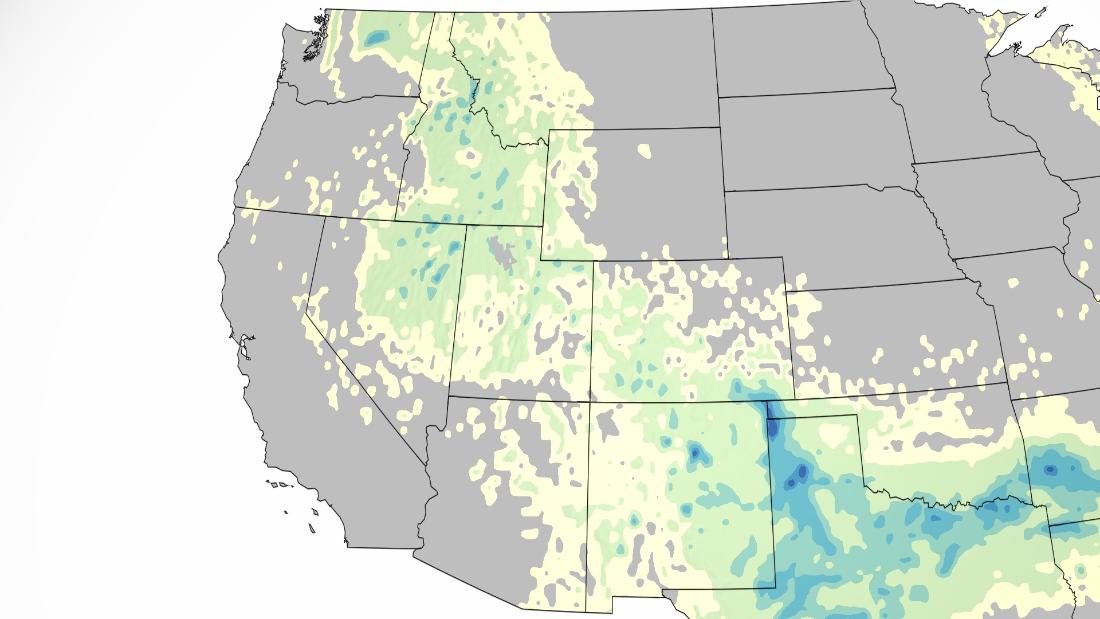
The annual rains can be both a welcome old friend and a bitter enemy. Heavy monsoon rainfall in the region will continue this weekend through the start of the week, bringing with it both life-giving moisture for the parched earth and the threat of more damaging flash flooding.
Widespread monsoon moisture spreads across the West through the weekend, northward into Oregon, Washington, Idaho, Wyoming, and Colorado.
"Monsoonal moisture continues to bring much-needed rainfall to the drought-stricken regions of the West. This broad area of monsoonal showers and thunderstorms is expected to show increasing focus across central Colorado as well as spreading farther north into the northern Great Basin today, where the threat of heavy rainfall and flash flooding will increase," the Weather Prediction Center said.
Strong thunderstorms bearing heavy rainfall, lightning, and gusty winds are possible across the region. Although the moisture could help improve drought conditions, the risk of flash flooding is high.
"Another round of thunderstorms in a high monsoonal moisture environment is expected today, with a flash flood watch in effect for much of the region through Sunday morning," said NWS Las Vegas.
Flash flood watches are scattered across half a dozen western states on Sunday due to heavy rainfall continuing through the early part of the week.
Heavy rainfall spread up the Rockies into southwestern Wyoming, through much of Idaho and eastern Oregon on Saturday. Arizona, Nevada, and the far eastern parts of California expect to see up to an inch of rainfall through the weekend.
On Sunday, the region of the strongest storms shifts northward, stretching up through eastern Washington and parts of Montana. A new area of concern develops Sunday over New Mexico and western Texas.
The rain is crucial for the Pacific Northwest where fires have plagued the area throughout the summer amid historic drought conditions and multiple record-breaking heat waves.
Battling fires in the Northwest
The US currently has 87 large fires burning over 1.7 million acres of land, 23 of which are in Idaho. Montana is also feeling the strain of fire season with 21 large active fires. California and Oregon are experiencing extreme fire conditions, with the country's two largest fires growing to consume hundreds of thousands of acres.
Air quality alerts are in place across Montana and parts of Wyoming due to smoke from the fires in the West and in Canada. The smoke is so bad in some locations that the Minnesota Pollution Control Agency (MPCA) has deemed this an "unprecedented significant air quality event for Minnesota."
Air quality is expected to reach the "purple" (5 out of 6) level, which is very unhealthy for everyone, not just sensitive groups. The alert went into effect Friday at noon and continues until 12 p.m. Tuesday, according to the MPCA.
The monsoon moisture moving into the region this weekend could potentially stomp out some fires and quench the dry vegetation and soil, but it could also cause more dangerous conditions.
"Lightning and high fire danger will likely result in new fire starts. Gusty thunderstorm winds could contribute to fire spread. Despite rainfall, initial attack resources could be overwhelmed and holdover fires are possible," said the National Weather Service office in Medford, Oregon.
Red flag warnings are in place across central and eastern Oregon for the weekend, where the potential for thunderstorms has drawn out worries for more fire starts. The Bootleg Fire in the region has already blistered over 400,000 acres of the Oregon hills, and lightning and strong winds from monsoon thunderstorms could start more fires, further straining resources.
The rainfall might help control some fires in the region. But left behind will be the scorched earth that is prone to runoff and flash flooding.
Flash flooding on the scarred hills
Saturday, heavy rain is forecast to impact Colorado once again, where mudslides already blocked off a major interstate on Friday, leaving 100 people stranded in their vehicles.
The mudslide occurred in the area of the Grizzly Peak Fire that burned thousands of acres in 2020, leaving behind a massive swath of charred earth ripe for flash flooding.
Nearly 3 million acres have already been chewed through by wildfires this year across the country, many of which were in the West, adding to the record-breaking 2020 fire season that saw over 10 million acres of land scorched.
The burn scars left behind are especially susceptible to the dangers of heavy rainfall, even years after the wildfire has been extinguished.
Burnt soil is extremely repellent to water absorption, acting more akin to pavement than a sponge. This can spell bad news in terms of flash floods.
Even areas far downhill and downstream from burned regions can see the effects of flash flooding and experience debris flows because of the water adverse nature of the scarred areas.
"A good rule of thumb is: 'If you can look uphill from where you are and see a burnt-out area, you are at risk,'" said the National Weather Service.
"heavy" - Google News
August 01, 2021 at 04:03PM
https://ift.tt/2V9GvM4
Heavy rains this weekend threaten drought-stricken West with floods - CNN
"heavy" - Google News
https://ift.tt/35FbxvS
https://ift.tt/3c3RoCk
heavy
Bagikan Berita Ini














0 Response to "Heavy rains this weekend threaten drought-stricken West with floods - CNN"
Post a Comment